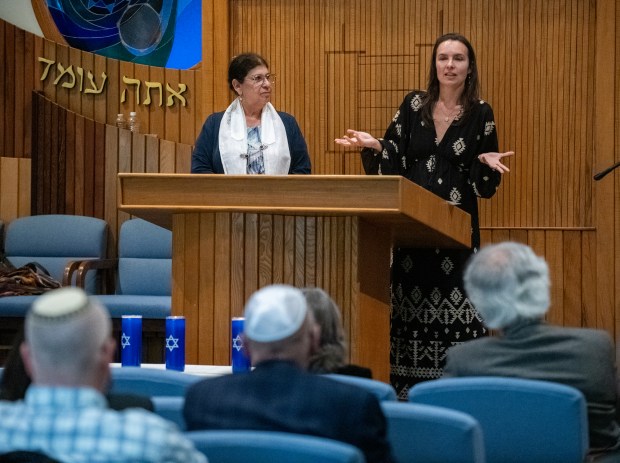A trip to Poland makes the horrors of the Holocaust really hit home, University of Notre Dame professor Emilia Justyna Powell told members of Temple Israel Valparaiso Friday during a Holocaust Remembrance Day service.
“I think everyone should go not only to see what happened but to recognize the gravity of what happened,” she said.
Powell takes a small group of students to Auschwitz each year to tour the Nazi death camp.
“At some point, every student starts to collapse,” she said.
The horrors of the Holocaust hit home when the sheer numbers are visualized.
Friday, six candles were lit to represent the 6 million Jews who died during the Holocaust.
Rabbi Shoshana Feferman listed who each candle represented – helpless infants, children and teenagers; all others who died with children in their arms; mothers and fathers cruelly separated from their families; scholars, teachers and rabbis who were the first to be seized; heroes of the resistance who fought against the Nazis; and martyrs who gave their lives to help protect brothers and sisters against the Nazis.
“Sadly, 2 million victims were never identified,” Feferman said. Simply reading the names of all the victims nonstop would take 11.5 years, she said.
Powell noted she didn’t prepare a PowerPoint presentation with images. “Some things are just too much,” she said.
She grew up in Poland, closely connected with the Holocaust. Powell’s birthday is Sept. 1, the day on which World War II began.
“The travesties that happened in the Second World War were part of our lives,” she said. Some of her family members died during the war.
“That’s not something you want to hear as a child, that your grandmother at 30 years old was killed by children,” Powell said.
“As we recited today, we can never forget,” she said. “Many people do forget.”

On the trips to Poland, Powell gives important lessons on international law.
“When you think of it, everything the Nazis did was legal,” she said. Domestic law wasn’t sufficient to protect the Nazis’ victims.
Before World War II, international law didn’t focus on individuals, except pirates, Powell said. The war changed that.
Rafael Lemkin, a Jewish lawyer from Poland, coined the term genocide in 1944. Lemkin had fled to the United States. Forty-nine of his relatives were murdered during the war.
In 1948, Lemkin persuaded the United Nations to classify genocide as an international crime.
That required creating a definition of genocide, which the UN defined as “acts committed with intent to destroy, in whole or in part, a national, ethnic, racial or religious group,” Powell said.
Those acts include killing members of the group; causing serious bodily or mental harm to members of the group; deliberately inflicting on the group conditions of life calculated to bring about its physical destruction in whole or in part; imposing measures intended to prevent births within the group; and forcibly transferring children of the group to another group.
Not only is the act of genocide punishable but so are conspiracy to commit genocide, direct and public incitement to commit genocide, attempt to commit genocide and complicity in genocide.
“When you transfer children from one group to another, after a while they lose their identity,” Powell said.
When she became a mother, the sorrow and distress she felt when she visited Auschwitz deepened. The tiny shoes representing children murdered by Nazis make the horrors seem more real.

Holocaust survivor Eva Mozes Kor pulls her sleeve up to show a tattoo, forced on her as she was imprisoned at Auschwitz-Birkenau concentration camp, as she speaks to a crowd of people on Nov. 12, 2018, at Valparaiso University.
Nazi doctor Josef Mengele did experiments on children, among them Eva Kor, who survived the Holocaust and later moved to Indiana. She and her twin sister, Miriam, survived, but their parents and older siblings were killed in the gas chamber.
“Many children called Dr. Mengele father,” Powell said. What the young children experienced in the death camps was reflected in the children’s drawings, depicting things like blood, gore and dogs eating corpses.
Reading about it, you don’t get the same feeling as walking in that place, she said. “We don’t see the people. We don’t see the individual names. There were many children, tiny children,” she said.
Just walking through the streets, realizing there are bodies buried underneath, hits home for her students. “These are people that will never see people in the same way,” she said.
Powell said about half the students she takes decide to go to law school and major in international law. The oldest students have been out of law school only about five years, so they don’t have enough experience to make a major difference in the world yet, but she has faith in them.
She warned against propaganda in education, noting people will believe what they’re taught. That fueled complacency in Nazi Germany.

One of the museums her students visit has original newspapers and books with anti-Jewish propaganda. Among them is a copy of the children’s book, “The Poison Mushroom,” in which a male Jew gives candy to German children and the children get sick.
“Propaganda was a huge part of the Nazi regime,” she said. “It was an instrument of genocide.”
“What you learn from your parents, what you learn from your grandparents, in a nice colored book, it’s going to stick with you,” Powell said.
Doug Ross is a freelance reporter for the Post-Tribune.





